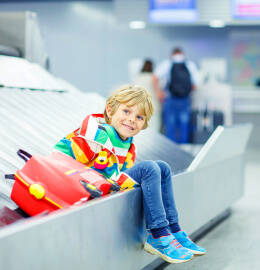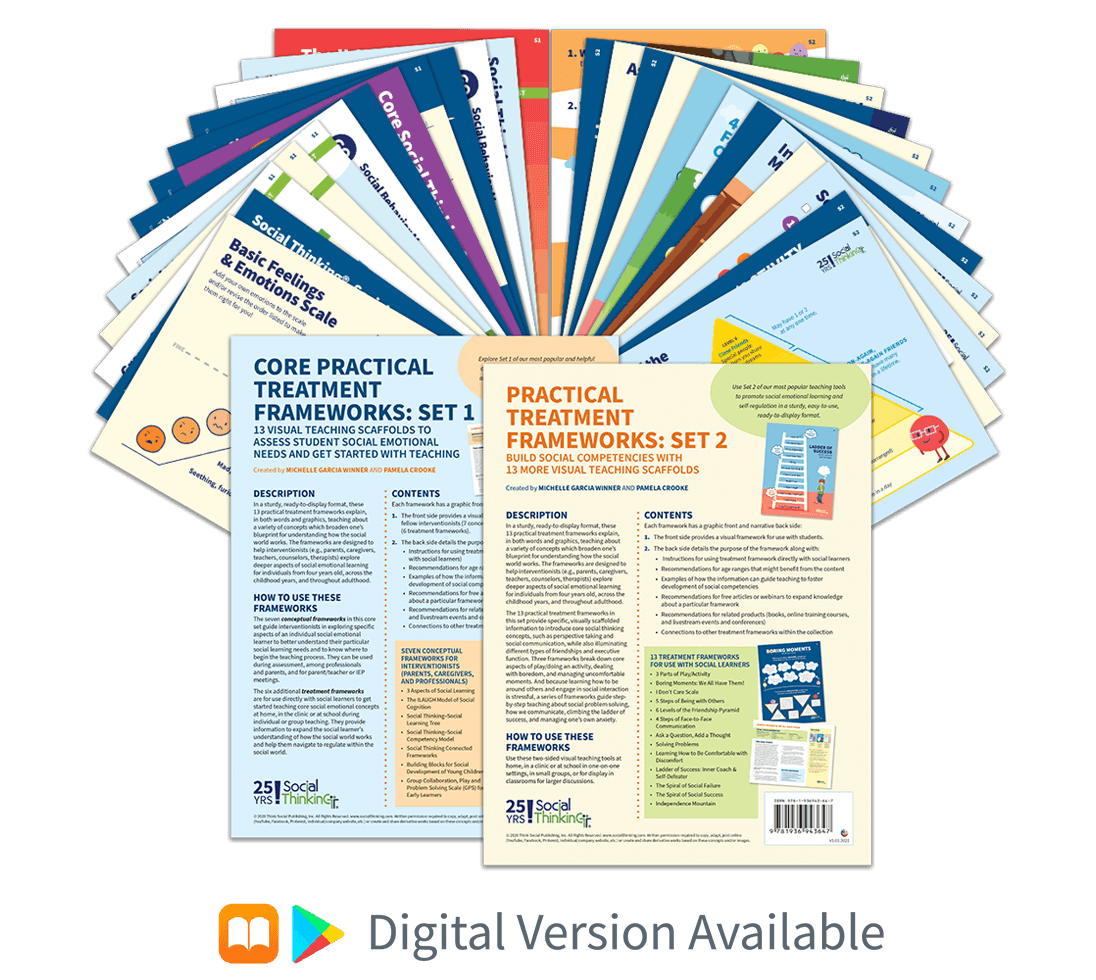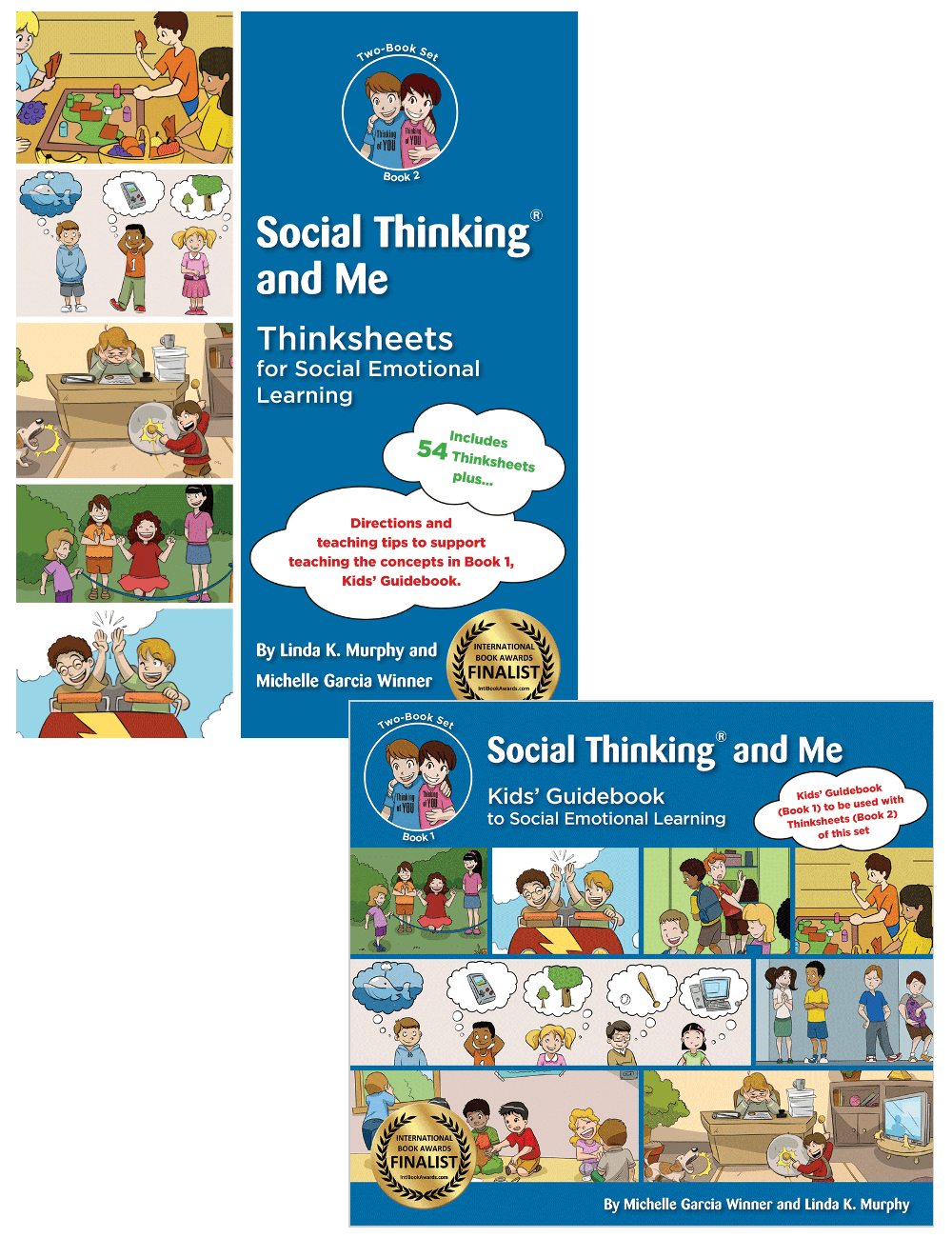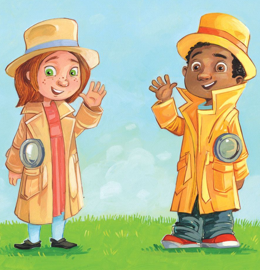Updated: June, 2023
© 2023 Think Social Publishing, Inc.
Picture your perfect vacation! Are you imagining a peaceful mountain resort, tropical white-sand beaches, or an adventure at a theme park? Though fun and exciting, traveling pushes us out of our normal routines and comfort zones as we find ourselves having to navigate new environments and figure out different social expectations. Unexpected schedule changes and constant negotiations to shift and follow the group plan can lead to unpleasant interactions and big reactions. When we travel with individuals with social learning challenges, it is important to recognize some of their stressors and build in strategies to help them.
These exercises are designed for both children and teens; some activities are more complex than others. As a family, you can decide which strategies will be most effective, as not everyone with social learning challenges may have the same strengths or struggles. Keep in mind that with some forethought and a little planning on your part, your older children and teenagers can be actively involved in the planning and problem-solving process during your travels. As a parent, you can use this time to let them practice taking a bigger role in navigating social situations on your vacation (e.g., getting from point A to B, requesting help from staff). Just be sure you’ve provided any pre-teaching, tools, and/or strategies that will help them be successful!
Creating the Vacation Itinerary
- Go over the group plan or itinerary with all traveling companions. After deciding on your travel destination, sit down as a family to look over the itinerary. Discuss how everyone has different likes and dislikes, but the group plan incorporates everyone’s preferences. For example, “Everyone in the family has different activities they like and don’t like. Monday, we will be going to the beach because Mom loves the beach. We will eat Mexican food for dinner since John likes Mexican food, etc.” If possible, you can even plan the trip together so it is an interactive experience with everyone contributing ideas about the activities they want to explore (see attached handout).
The purpose of this activity is twofold: 1) to give everyone an idea of what to expect on the vacation, which helps decrease anxiety, and 2) to show how everyone’s ideas are incorporated into the group plan. This is a FAMILY vacation, not a PERSONAL vacation. In this way, everyone can plan to be a “thinking of others” family member!
- Include “OWN TIME” in the itinerary. Explicitly set aside a certain amount of time each day, such as 30 or 60 minutes, during which everyone in the family will have his or her “own time.” Being on vacation can be stressful and everyone can benefit from an established break time each day to decompress. During this time, everyone can choose how they would like to relax (e.g., listen to music, play a video game, watch TV, go on the Internet).
Many individuals with social learning challenges can better regulate their emotions if they know how long they are expected to follow the group plan. They can look forward to their “own time” each day as a time to follow their own plan. It is important to emphasize that this “own time” is not a reward. Instead, it should be seen as a way of modeling how incorporated breaks are helpful for everyone!
Tips While on the Vacation
- Discuss potential problems at the beginning of the day. Take a few minutes each morning to go over the itinerary and discuss what might not go as planned: a delayed plane, traffic on the freeway, a cancelled tour, annoying people in your tour group, closed restaurants, etc. The only thing that is almost guaranteed on any vacation is that at least one thing will go awry. Awareness and anticipation of potential problems are often the first steps to decreasing emotional reactions.
For students who have been introduced to Social Thinking’s Size of the Problem Scale*, use this time to practice identifying problem sizes and matching the reaction size. For each potential problem you come up with, identify the size of the problem (small, medium, big) and talk about possible expected/unexpected reactions to reinforce the concept that problems and their respective reactions come in different sizes.
*If your child has not learned about problem-reaction size, introduce the problem scale prior to the trip; you should not be introducing new strategies during the vacation. (Size of the problem and reaction size is introduced and discussed over two chapters in Social Thinking and Me, a two-book set with kids' guidebook and accompanying thinksheets for ages 9-13, by Linda Murphy and Michelle Garcia Winner (2016); for ages 9-13.) - Problem solving in the moment: Traveling is a great time to practice social problem solving. As a parent, you can model how you solve problems throughout the day, as well as bring a visual to help talk children through their problems. Problem solving and stress often go hand in hand. Here are a few simple and effective strategies to use on vacation:
- Help individuals regulate their emotions before talking about the problem. Allow the person who is getting stressed to take “time to chill out.” You might create a visual break card or a signal (tap on the shoulder) the person can use to indicate they need to take a break and calm down. On the other hand, if you notice that someone is demonstrating signs of frustration, you may have a signal you send as a reminder to take a break. When people with social learning challenges get dysregulated, talking through a problem is difficult until they have the time to calm their mind and bodies. Once calm and regulated, they may then be able to talk through their problem and the related strategies to deal with the on-going stressors of traveling.
Bring a visual of Social Thinking’s Size of the Problem Poster. Carry a copy of the Size of the Problem poster with its emotion thermometer as a visual cue to help kids and teens recognize the size of the problem they are dealing with (see attached handout). Remember to make sure children are regulated and calm before trying to talk through their problems; their emotions and reaction size may escalate if they are presented with more verbal/visual information than they are ready to process.
Small Problems: Most of the problems that we face on vacation are small problems. These are problems we can pretty much manage ourselves and may include feelings of boredom because of delayed flights or waiting for others in the group, annoyance from loud noises in the hotel or lack of personal space, or disappointment when a fun activity is cancelled due to weather. To deal with small problems:
- Acknowledge that these feelings are common during a vacation and discuss the expected ways to express these feelings with words rather than actions/behaviors. Often, neurotypical individuals hide their feelings of irritation and boredom with a social flip, which can result in individuals with social learning challenges thinking they are the only ones with these negative feelings. Acknowledging that feelings of boredom or irritation are “normal” and reiterating how much time is left can be helpful in decreasing reaction size. “I get that you’re bored. I’m bored too, but we’re showing John we’re thinking about him by participating in this activity. We only have to do this for 10 more minutes!”
- Use self-talk: Talking out loud through your thinking process when you are dealing with problems throughout the day can be a great model of expected ways to problem solve. “Darn, the snorkeling tour is cancelled. I’m so disappointed because I heard the reefs here are beautiful. It feels like a really big problem, but I have to remind myself we can try the tour another day and find something else to do today. No one is to blame and having a big reaction does not make the problem smaller. If everyone is safe and healthy, my emotions might feel very big, but it’s probably a small problem.”
Medium problems: Medium-sized problems are not as common as small problems and include problems that may affect your entire family or problems that require help from adults, such as police or security staff involvement for pickpocketing. Other medium problems might include the airline losing your luggage on the flight to your destination, or you/your family getting sick while on vacation and needing medical attention.
Big problems: Big problems are unlikely to occur. These affect a lot of people at one time and even adults are so overwhelmed they can’t solve these problems on their own. Examples of big problems include an airplane crash, tsunami, or a hurricane. If students suggest that their problem is a big problem, you might ask them to rate their problem compared to these big problems to put their problem in perspective. “Does a cancelled tour seem like a bigger or smaller problem than a car crash?” Be sure to talk through the idea that the feelings on the inside may feel really big, but the goal is to manage those feelings around the true size of the problem, so our reactions are expected for the size of the problem.
-
Create a vacation journal and have everyone write their daily impressions about the trip. Take a few minutes at the end of each day to write or draw about the day’s activities and your impressions. This can be as structured or as unstructured as you like; see attached handout for journal templates.
TIP: Focus on the positive! Although some level of stress is expected during vacations or travel, the main focus of reflective discussions should be on the positive aspects of the day’s events.
Benefits for taking a few minutes to reflect at the end of the day:
- You can use this time to help your child or teen shift any negative thoughts and feelings by finding the humor in unexpected events. For example, “Remember when we got lost at the airport? It was very stressful in the moment but looking back, it was pretty funny how we passed the SAME store three times before we realized it!”
- You can use this time to praise expected behaviors during the day. Give your child or teen positive feedback for what they are doing right. “I really liked how you let your sister go first in line even though I could tell you wanted to go first.” It can also help them appreciate how others are going out of their way to help them feel more comfortable on vacation. “Did you notice that we avoided the fireworks because we knew you don’t like the noise?”
- You can compare how they narrate the day with what actually happened. Sometimes your child or teen may report an event at school, and you are not sure how the event actually played out. On vacation when you spend most of the day together, you can compare what actually happened and how your child narrates the situation to get a better idea of your child’s social perception.
This is by no means a comprehensive list of strategies for traveling with an individual with social learning challenges. The take-home message is to think about this ahead of the vacation and do.
Thinksheet: Preparing for Vacation Time
Sample Itinerary
Create one itinerary for each day of the trip. The “Potential problems” column can be left blank and filled in after the trip begins as a way to prepare for each day. For teens and young adults, the itinerary can also be discussed verbally.
|
Approximate time |
Activity |
Whose plan? |
Potential problems, Strategy or What I can think/do |
|||
|
9:00 am |
Wake up/breakfast |
|
|
|||
|
10:00 am |
Beach |
Samantha |
May be really hot and uncomfortable Self talk: It’s only for an hour! |
|||
|
12:00 pm |
Lunch/John’s choice |
John |
May not be the food others want to eat Self talk: It’s just one meal; I get to pick the meal tomorrow. |
|||
|
1:00 pm |
Own time: play video games, read a book, listen to music |
|
|
|||
|
2:00 pm |
Souvenir shopping |
Jessica |
May be boring for others Self talk: Maybe I can find something I like! |
|||
|
7:00 pm |
Dinner with extended relatives |
Parents |
Can be stressful when asked personal questions Self talk: I only have to see them once a year. I can do the social flip! |
|||
|
9:00 pm+ |
Journal: 5-10 minutes |
|
|
|||
Sample Journal Templates
Here are some ideas for daily journals:
- Photo Journal: For individuals who don’t like to write or type, they can take pictures and put them in an online album on their phones, a tablet, or a computer.
- Drawing Journal: Kids or teens can draw pictures of their favorite part of the day.
- Written journal: Individuals can write about their impressions of the day or things that went well/didn’t go well. This can be done on a laptop or on a tablet, or their cell phones with an app like Google docs.
- General journal: includes the date and impressions of activities
Wednesday 6.14.23 (Sample from neurotypical teen)
- woke up around 830 got ready to leave for turtle sanctuary
- when we were all ready to go, we discovered that one of the golf cart engines didn’t work and exchanged it for another- the engine had been stolen
- drove to sanctuary saw LOTS of little baby turtles
- like omg there were maybe like 100 baby turtles in a lil confinement - i was quite concerned for them some looked like they were dead
- Use a blank version of a Social Situation Map.
POSITIVE
What was the situation: getting lost and not panicking
What you thought about the situation: oh im lost and cant find the others
What you felt: nervous but in control, stayed calm, didnt freak out
What others thought: where is he? i thought he went with you?
What they felt: a bit nervous
Did what you did or said in the situation match? How? How not?
I handled the situation well
VERSUS
What was the situation: water pressure was low in shower in hotel room
What you thought about the situation: this is so stupid whats the point in taking a shower if the water is this unmoving and putrid?
What you felt: very angry and annoyed
What others thought: why is he acting up like this?
What they felt: confused and annoyed
Did what you did or said in the situation match? How? How not?
What could you have thought or done to match others?
It did not match the situation, it was a classic little problem big reaction situation
(Sample from teenager with social learning differences and/or challenges)















